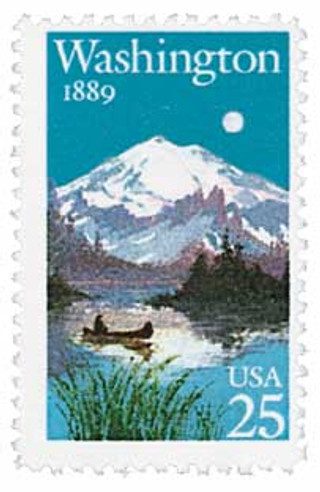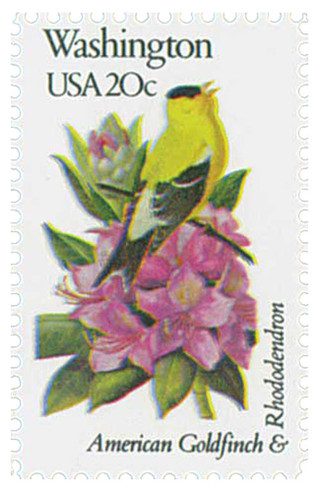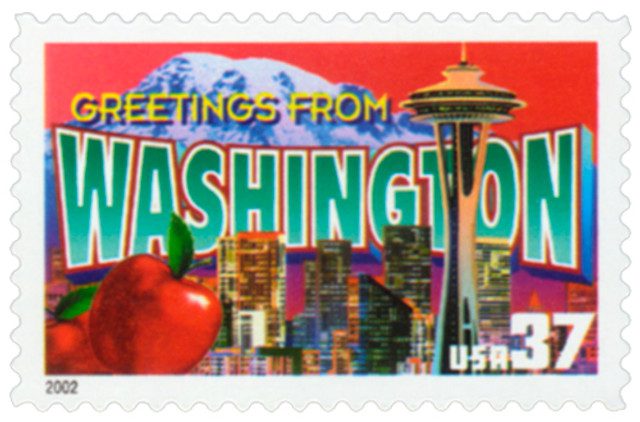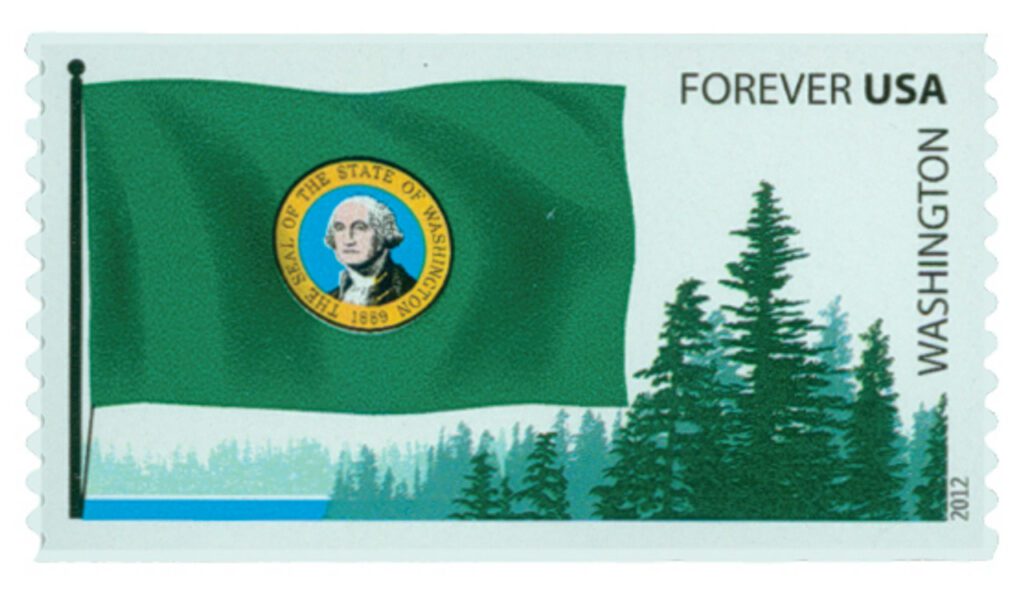On November 11, 1889, Washington was admitted to the Union. Ever since, it has stood at the forefront of exploration, commerce, and progress in the American West.
Before the arrival of Europeans, a large number of native American lived in what would become the state of Washington. The Cayuse, Colville, Nez Percé, Okanogan, Spokane, and Yakima tribes lived on the plains and in river valleys. The Chinook, Clallam, Clatsop, Nisqually, Nooksack, and Puyallup lived along the coast, west of the Cascade Mountains.
Spanish and English explorers sailing north from California in the 1500s were probably the first Europeans to sight Washington. However, they didn’t set foot in Washington until the late 1700s. When Russian fur traders settled in Alaska, the Spanish became worried they might also claim Washington. As a result, the Spanish sent several expeditions to the area to reinforce their claim. In 1775, Bruno Heceta and Juan Francisco de la Bogeda y Quadra were the first whites to land on Washington soil.
1n 1778, Captain James Cook became the first English explorer to reach this area. However, he did not get to view much of the coast, due to stormy weather. The English Captain George Vancouver completed surveys of Puget Sound and Georgia Gulf in 1794. His officer, Peter Puget, reached Puget Sound in 1792. These explorations were the basis for England’s claim to the region.
The first American to reach Washington was Captain Robert Gray of the Boston Company. Gray headed a fur-trading expedition that sailed into the harbor that now bears his name. He reached the mouth of the Columbia River in 1792. Gray’s explorations became the source of American claims to the area. In 1805, the Lewis and Clark Expedition explored Washington by following the route of the Columbia River to the Pacific Ocean. The Lewis and Clark Expedition gave America another claim to the land of the northwest.
By the early 1800s, fur traders from US and Britain had settled in the region. In 1810, the Canadian North West Company established Spokane House near today’s Spokane. Fur trader John Jacob Astor established the first permanent American settlement with the founding of Fort Okanogan.
The fur trade was interrupted by the War of 1812. After the war, Britain and the US could not agree on how to separate the land west of the Rocky Mountains. In a compromise, it was decided citizens of both countries could settle this vast area, then known as Oregon Country. However, by the 1840s, a large number of Americans had settled the Oregon Country, and boundary dispute became a bitter issue.
During the presidential election of 1844, James K. Polk based a great deal of his campaign on the idea that any land south of latitude 54º 40′ belonged to the US His supporters used the slogan, “Fifty-four forty or fight!” President Polk signed a treaty with Great Britain that set the boundary at the 49th parallel, Washington’s current border, in 1846.
The Oregon Territory was created in 1848. Washington was part of this vast piece of land until 1853, when President Millard Fillmore created the Washington Territory. The Washington Territory included all of today’s Washington and parts of Idaho and Montana. The territory was expanded to include the southern parts of Idaho and Wyoming in 1859.
When the Idaho Territory was established in 1863, Washington received its current boundaries. Washington’s population grew fast, fueled by the discovery of gold in Idaho, Oregon, and British Columbia. Yet, there were no major gold strikes in Washington. Many gold prospectors remained there and became farmers or loggers.
In 1883, Washington Territory was connected to the rest of the country by the Northern Pacific Railroad, spurring a surge of settlers and rapid population growth. The expanding economy and growing towns strengthened the call for self-government. On November 11, 1889, President Benjamin Harrison signed the proclamation admitting Washington as the 42nd state, with Olympia designated as the state capital.
Irrigation helped farmers cultivate much of the area’s dry, desert-like land. Fruit growers and wheat farmers thrived in Washington’s climate. Logging, fishing, and mining all played important roles in the state’s growing economy. The Klondike and Alaska gold rush of 1897-98 brought the state a great deal of wealth. Seattle served as the major supply center for prospectors. Washington also profited from shipping to the Far East.
Washington’s economy boomed with World War I, suffered through the Great Depression, and boomed again with World War II. During WW II, the state’s industries produced aircraft, ships, trucks, and railroad cars. In 1943, the US government built a nuclear energy facility there, named Hanford Works. Hanford Works played a key role in developing the first atomic bombs. In 1960, it began generating electricity. Today, the facility is known as the Hanford Site of the US Department of Energy.
Many Washington cities benefited from the construction and expansion of US military bases. Over time, the importance of farming and logging in the state’s economy has declined. The development of the Columbia River has helped farmers with much-needed irrigation water and opened the river to navigation.

In 1962, the Century 21 Exposition was held in Seattle (it was also known as the Seattle World’s Fair). At the center of the fair was the 607-foot Space Needle observation tower. It remains a major tourist attraction. In an attempt to improve tourism, $130 million was spent to clean up the pollution in Lake Washington and Elliott Bay.
The expansion of the Boeing Company, an aviation manufacturer, caused the Seattle and Puget Sound areas to grow rapidly during the 1960s. At one time, nearly 10 percent of Washington’s workers were employed in the jet aircraft and related businesses. During the late 1960s and early 1970s, the aviation and aerospace industries experienced a sharp decline. By the mid-1970s, the industry had recovered, due to the need for more jet-powered aircraft.
In the decades following its early industrial roots, Washington worked to diversify and strengthen its economy by attracting new industries and developing a highly skilled workforce. The state’s emphasis on technology and innovation drew major electronics companies and laid the groundwork for future growth. In the 1970s, the Washington Public Power Supply System (WPPSS) launched an ambitious plan to build five nuclear reactors to meet expected rising energy demands. However, demand didn’t increase at the rate expected, which combined with cost overruns, led to the completion of only two plants and a default of more than $2.2 billion in municipal bonds—the largest of its kind at the time. Despite that setback, Washington’s economy rebounded as the technology sector flourished. The establishment of Microsoft’s headquarters near Seattle helped transform the region into a global hub for software development and innovation, solidifying the state’s reputation as a leader in the modern economy.
| FREE printable This Day in History album pages Download a PDF of today’s article. Get a binder or other supplies to create your This Day in History album. |
Discover what else happened on This Day in History.







One could truly marvel at the illustrious history this article portrays. With a plethora of interesting facts detailing the profound impact monumental sites such as: The Space Needle present it’s no wonder how they have become such a symbolic representation of America’s 42nd State.
God Bless & a Happy Armistice Day (commonly referred to as Veterans Day) to all,
Donald R. Hower
Great information about the State of Washington. I enjoy these every day.
Great job of describing our beautiful and diverse home called the ‘Other Washington’ by many.
The Native Americans went where?
A great example of what happened to them is contained in the story of the Nez Perce. Read about Chief Joseph and his run to get to Canada with his people. They almost made it. It was documented recently in a Mystic blurb.
Great article about a State in which I lived for six years; however, today is Veterans Day and I would have much rather learned something about Veterans Day/Armistice Day that I did not know. Nothing against Washington…great State, but I believe Mystic missed something here.
Click on the link to see what else happened on This Day in History. It has very good info on the World War 1 Armistice. I click the link every day and get a double dose of history.
Great stories on both the Armistace and the state of Washington, where I have lived since 1961. And today is also my 75th birthday! What a coincidence!